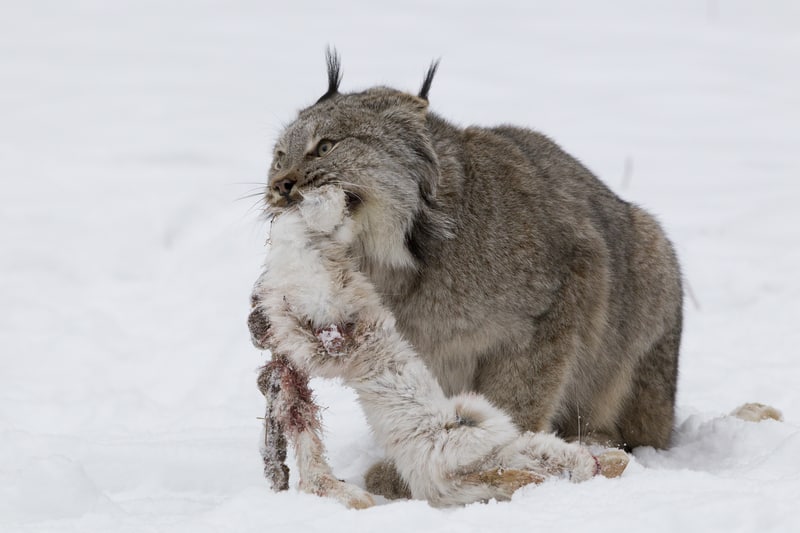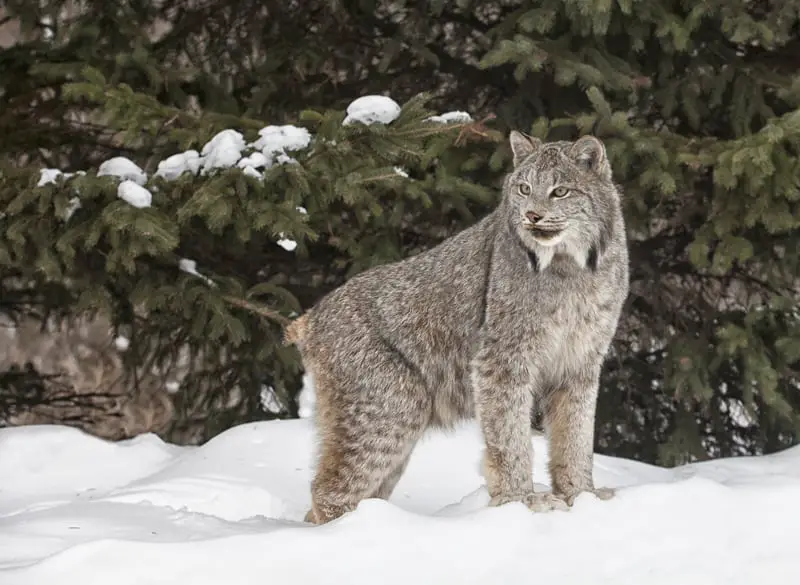Scientific name- “Lynx canadensis.”
The Canadian Lynx is sometimes also known as the Canada Lynx. They are medium-sized wild cats that live in the boreal forest regions of Canada and the northern United States. Additionally, they are 1 of 2 North American members of the “Lynx” genus. The other one is the bobcat.
[joli-toc]
Canadian Lynx Characteristics
What does a Canadian lynx look like? Canadian Lynx closely resemble their close relative, the bobcat but with some differences. First of all, they are slightly larger than bobcats. They are up to 35 1/2 inches “90 cm” long and 26 inches, “65 cm” tall. Additionally, they weigh up to 37 and a half pounds, “17 kg.
Canadian Lynx have triangular pointed ears with black backs and long tufts of black hair on the tips. The hair tufts are much longer than a bobcat’s. They also have drooping flared facial ruff of white hair on the sides of their face beneath their chin.
Additionally, they have yellow eyes with vertical black pupils.
Lynx have long legs in proportion to their bodies, with their hind legs being slightly longer than their front ones. This gives their body a peculiar, sloped appearance.
Canadian Lynx have almost comical-looking oversized fur-covered feet. There’s a good reason for this. Their feet function like snowshoes, allowing them to travel and hunt on top of the snow. Canadian lynx feet can keep almost twice as much weight from sinking into the snow as those of a bobcat. This is why Canadian lynx range over the deeper snow country of northern Canada while bobcats do not.
Canadian Lynx have long thick grey fur in the winter. By summertime, they have shed their grey fur and have a thinner, shorter reddish tan hair coat instead. Their color is more uniform than that of bobcats. While bobcats have black spots and mottled coloration over their entire body, Lynx are solid tan except for some mottled darker brown spots on their legs.
Canadian Lynx Range
Where do Canadian Lynx live? Canadian lynx range over most of Alaska with the exception of the Yukon –Kuskokwim River delta on the Bearing Sea and the southern end of the Alaska Peninsula. Source
They also range over most of Canada, with the possible exceptions of southeastern Alberta, southern Saskatchewan, southwestern Manitoba, and coastal British Columbia. Although they venture beyond the treeline, they are absent from areas that are very far above it.
The vast majority of Canadian Lynx live north of the U.S/Canadian border. However, in the contiguous United States, several states have fragmented small populations of Lynx. In the western United States, the range of the Lynx follows the backbone of the mountain ranges south as far as the southern Rocky Mountains of Colorado and New Mexico. Additionally, Washington, Idaho, Montana, Wyoming, Utah, New Mexico, and Colorado all have Canadian Lynx. The Lynx was formerly extirpated from Colorado. They were successfully reintroduced to the state in 1999. Today there are between 150 and 200 Canadian lynx in the San Juan Mountains in southwestern Colorado.
Their range also extends east along the U.S/Canadian border. Ergo, there are Canadian Lynx in Minnesota, Michigan, Wisconsin, Vermont, New Hampshire, and Main. North Dakota, Ohio, Pennsylvania, and New York are missing from the list of border states with Canada lynx populations.
Canadian Lynx Habitat
Canadian Lynx primarily live in the boreal forest habitat of Canada and the United States. They’re biologically tailored for life in areas with high altitude dense forest growth and deep winter snows. One of the adaptations that make Canadian Lynx well suited to life in deep snow is their large fur-covered feet that function like snowshoes. They enable them to travel and hunt on top of the snow instead of sinking in it. This gives them a distinct advantage over other predators. Their close relative, the bobcat, does not range as far north as the Lynx because they cannot deal with deep snow like the Lynx can.
Canadian Lynx Diet
What do Canadian Lynx eat? Mice squirrels, ptarmigan, grouse, ducks, deer, Dall sheep, and caribou make up a minor portion of a Canadian lynx’s diet. However, they have adapted to mainly prey on snowshoe hares.

Lynx and snowshoe hare
Canada Lynx is very dependent on snowshoe hares as a food source. In some areas, hares comprise 75 percent of their total diet. In fact, their population density is directly correlated with the snowshoe hare population. Canadian and Alaskan Canadian Lynx and snowshoe hares go through what is known as the Lynx-Snowshoe Hare Cycle. When food sources are abundant for hares, their population increases very rapidly since they can have several litters per year. When hare populations are at their peak, there can be as many as 1500 animals per square kilometer” 3913 per square mile”. At this time, the population of Lynx and other predators are also at their peaks.
Since the habitat cannot provide enough resources for so many animals, and there are so many predators, the hare population crashes. When the hare population crashes, the lynx population follows suit within 1 to 2 years. This cycle repeats itself about once every ten years.
In periods of snowshoe hare scarcity, Canadian lynx switch over to red squirrels as the main food source and have been documented to travel up to 1100 kilometers, “684 miles,” in search of range with a more abundant food supply.
Many Lynx don’t do as well with other food sources, particularly in winter, so malnourishment becomes a problem. Lynx that cannot adapt to other food sources die off, and females produce fewer litters of kittens. The litters that are produced have fewer kittens in them, and the kittens that are born are smaller and weaker. Most of these won’t survive to adulthood. Source
When predator numbers are low and food is abundant, the snowshoe hare population will rebound, and so the cycle begins again.
Interestingly, snowshoe hare populations in the lower 48 states do not go through the same decennary fluctuations as in the northern latitudes. The more temperate forests don’t support such large populations, but they also don’t go through the same boom and bust cycle. Therefore if lynx populations fluctuate, it’s for other reasons. Source Source
Canadian Lynx Predators
Humans are the main predator of Canadian Lynx. We trap them for their fur. Other predators include wolves, coyotes, cougars, bobcats, and fisher cats. Source
Canadian Lynx Behavior
Although you may see them any time of day, Canadian Lynx are mainly nocturnal. This is a behavioral adaptation to better hunt their main prey, the snowshoe hare, which is also nocturnal. Lynx are ambush predators. As such, they wait in concealment next to hare or other animal trails. When their prey come by, they spring from ambush. They dispatch their prey, whether that be a snowshoe hare or a young ungulate with a bite to head, the back of the neck, or a suffocating bite to the throat. Adult males and females without young generally hunt alone.
Lynx are solitary, territorial animals. They live and hunt in territories that they scent mark the boundaries of with urine or scat on prominent markers such as rocks or tree stumps. Their territories range in size according to the abundance or lack of prey animals. Male territories are larger than those of females. In northern Main, where snowshoe hares are abundant, male Canadian lynx territories are around 12 square miles while female territories are around 10 square miles.
In areas where the game is less abundant, territories may be as large as 85 square miles. Source Animals of the same sex work to avoid each other, but a male lynx’s territory might intersect several females’ territories.
Reproductive Behavior and Life Cycle for Canadian Lynx
Breeding season for the Canadian Lynx begins in late February and goes to early April. Lynx females are mono estrus, meaning they have one estrus cycle per year. Mating occurs with only one male and is in heat from 1 to 10 days. As discussed earlier, reproduction in Canadian Lynx is directly affected by the abundance or lack of their prey animals. If they successfully mate, their gestation period lasts 56 to 70 days.
The pregnant female will typically make a maternal den beneath rock ledges, a fallen log, in the root tangle of a fallen log, or a thick tangle of brush.
Lynx kittens are sightless for the first two weeks of their life. By the time they’re 5 weeks old, they’ll be big enough to leave the den. Their mothers wean them when they’re around 10 weeks old, and at 10 months, they’ll go out on their own. Source
Female Lynx are sexually mature at 10 months old, but they generally don’t come into heat for at least another year. However, in periods of prey abundance, yearling females will breed and give birth.
Male Lynx reaches maturity at around 33 months of age.
The lifespan of a Canadian lynx is somewhere between 10 and 20 years in the wild. They can live over 20 years in captivity.
Recent Posts
The only venomous snakes in Washington State are Northern Pacific Rattlesnakes. The Northern Pacific Rattlesnake (Crotalus oreganus oreganus) is a sub-species of the Western Rattlesnake. Anyone...
Skunks are not classified as true hibernators. But they go into a state of torpor when the weather gets cold. Skunks are light sleep hibernators, along with opossums, bears, and raccoons. ...

